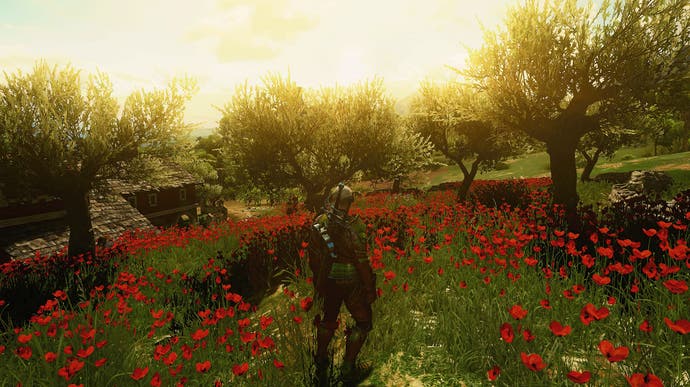Video games and the life of summer
Starring Witcher 3, Firewatch and Dishonored 2.
Summer landscapes can be taken for granted as bright and breezy backdrops to games. However, what spring started, summer finishes. Following on from the rebirth of spring, summer further fuels and invigorates the landscape. Lands become majestically colourful, gorgeously lush and bursting at the seams with life as the peak of the growing season and life cycle are hit. Bright sunlight basks the land in glorious light and stretches the days, while vivid foliage spreads as far as the eye can see, punctuated by glorious flowering plants, laying a carpet of life over the land. These are the hazy days of summer, indeed. Life breeds life and swathes of landscape are transformed, covered in lush foliage and colour, while the land becomes more productive, increasing interaction and function.
Summer has its own meaning, and this can be injected into games through the landscapes they have and portray - and all of their elements they contain. Smash this wonderful, bright season together with narrative and story arcs and there is a new side to summer environments to be enjoyed and experienced.
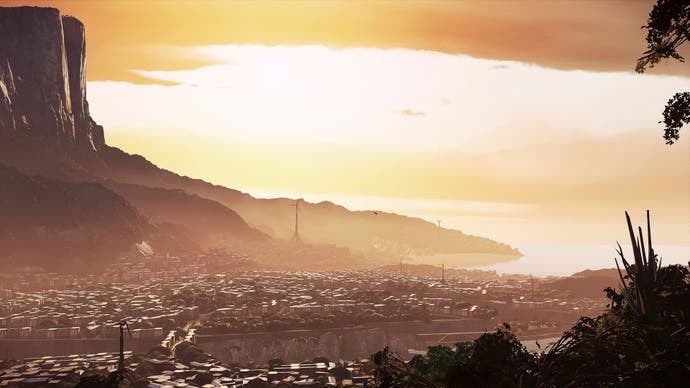
The success and majesty of The Witcher 3's landscapes are further elevated when examined through a seasonal lens as it can reveal even more environmental nuances and specific landscape features. The configuration of summer landscapes through fidelity, function and beauty underlines the environment's importance in contributing to The Witcher 3's place-making, story and atmosphere (particularly in Velen and Toussaint), but also demonstrate the sheer importance and power summer has over the landscape, guiding its life and character. Avoiding fawning over each individually hand-placed, wholly-accurate plant (this time) as examples of The Witcher 3's summer landscape, it is the active and productive horticultural landscapes that show summer's power.
In Velen, villagers work the fields, tilling, tending and preparing for the harvest, wheat or barley-like crops grow neatly in marked fields, and people attend the blooming orchards, ensuring their health and later harvest. The orchards being in bloom and not quite in fruit yet would seem to indicate an early summer setting, but all these aspects of active horticulture demonstrate a productive and active summer landscape. Smaller, productive, vegetable-looking plants abound and smaller fields and field edges are chock-full of sunflowers, being grown for more than ornament alone, their tall, wavy forms providing a sunny aspect to fields in White Orchard. By using a summer setting in combination with the medieval feudal system, The Witcher 3 demonstrates how the landscape is vital to the people and the wider setting. It is crucial the villagers and inhabitants have a close relationship with the land, particularly in summer, as it contributes to the economy, social structure and production of food. None of this would be possible without summer and these demonstrations give enormous depth to the setting, beautifully wrapped up in an accurate summer package.

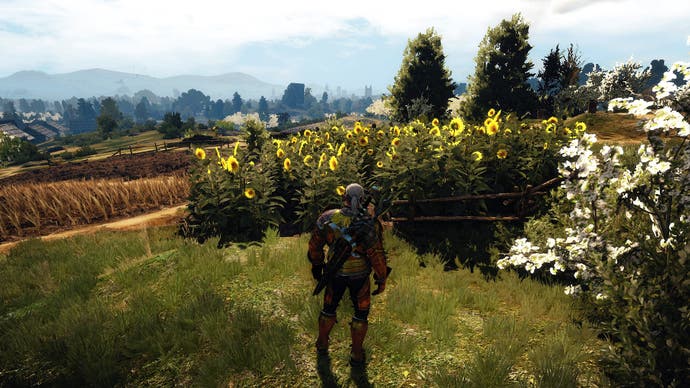
This concept of active summer landscapes is also particularly present in Toussaint. Being a gorgeous depiction of a Mediterranean-esque land, a dominant landscape element is its vineyards. One of the most pleasing landscape features, particularly when en masse, due to their satisfying and uninterrupted linear layout that sweeps over every contour of the land and is incredibly pleasing and neat, reinforced by each individual plant's form - upright, narrow and architectural. The vineyards are hives of summer landscape activity, with workers weaving through them, magically disappearing and appearing, tending to vines by pruning and tying, and harvesting the fruits of their labours.
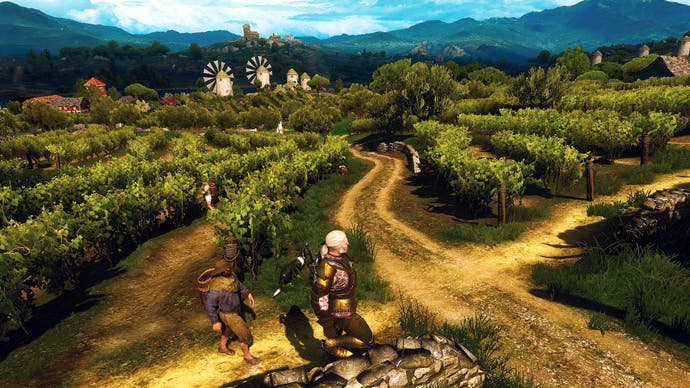
Often close to the vineyards, but located throughout Toussaint, are olive trees. They are everywhere, and for good reason, as they are an important species in a summer landscape: their heritage, produce, look and form all conjure up images of a Mediterranean summer and evoke its feelings in plant form. For example, the image of rustic stone buildings perched on the sides of rolling hillsides, surrounded by lavenders and rosemaries punching through rocky soils is a powerful Mediterranean one, but is only complete with the addition of olive trees. Their old and gnarly trunks and branches leaning at angles, smothered in silvery-grey-green leaves, glimmering in the sunshine and rippling in a breeze. And one The Witcher 3 is able to recreate and reinterpret in the lands of Toussaint. The olive trees wider importance to a summer landscape is varied, powerful and stems from their geographical heritage. Very originally from the middle east, the warmest and sunniest parts of the known world, popularised and farmed before in places like Syria, Crete and Jordan, they have become a staple part of the Mediterranean landscape due in part to their popularity with Roman and Greek civilisations. At their most basic, Olive trees are important summer landscape specimens because they are fruiting trees, grown for produce - a recurrence of the productive summer landscape theme and their fruits mature and reach their peak in the summer months.
Beyond this, the summer months are when they are at their most lush and vivacious. Their old, gnarly trunks, each one completely individual, are offset by plumes of the delicate, silver-green leaves, displaying beauty and majesty. Combine this with an often informal arrangement and wild underplanting, and a gorgeous summer image, balancing perfectly the productivity and ornamental values of the tree, is complete. Their slow-growing nature, and ability to mature uniquely also gives them importance as horticultural contributors to summer landscape's identity and sense of place. The trees we see in Toussaint's landscape would take centuries to achieve their size, maturing through generations of rulers and denizens. Therefore, the trees intimate and give a nod to the longevity of Toussaint and Beauclair as a place. The fact olive wood, branches and oil was consistently used to anoint kings and queens and represent life and health, means these summer specimens are also important on a symbolic level to the high society of Toussaint extending well beyond their use as a productive, fruiting tree.
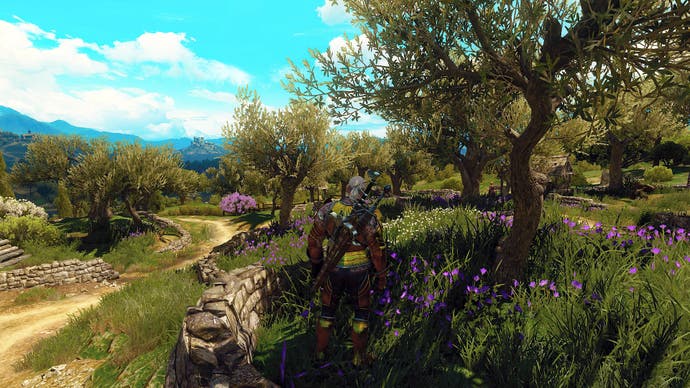
Not to be outdone by the productive plants, ornamentals do, of course, make a noteworthy appearance and contribution to the summer of The Witcher 3. After all this is the season of sunshine when plants really have to compete with each other for the attention of insects so they may reproduce. Blooms are brighter and more prolifically pronounced and also pump out attractive perfumes. This is clearly best on show in the palaces of Vizima and Beauclair: climbing flowering plants cling to walls and clamber up columns, dressing buildings, directly contributing toward their architectural character, changing their look for summer as well as their own; roses burst out of planters that are carefully placed along walkways to provide scent and exclamation marks of colour; and neat, manicured plants display colour and patterns that were only hinted at in winter and spring. In combination with the life-filled vineyards and olive trees, the colour and summer plants on show, particularly, in Beauclair act as a delightful foil and contrast for the dark events in the story and plot - not all is as pleasant as the landscape.
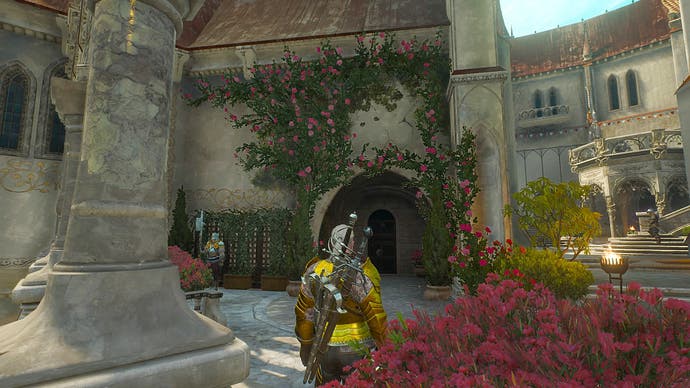
Lastly, despite all the beauty and magnificence of a well-executed summer landscape, right down to its plants, the season casts a melancholy shadow over the land, almost constantly. The warmer, drier and longer days meant summer was the season of conflict, battles and war campaigns in medieval times, and this is reflected here. Underpinning the whole setting of The Witcher 3, the ongoing war in Temeria provides a summer-based melancholy backdrop to the world that will not relent. Perhaps this makes the efforts of the villagers tending their orchards and farms even more powerful, going about their daily business, despite how necessary it might be, in the face of adversity. Beyond the active horticulture of summer, the war does provide a further element of human action and life in the summer landscape and provides another angle of place-making and setting.
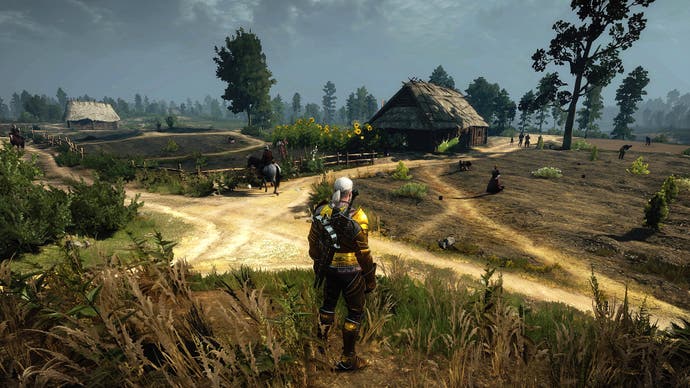
The Witcher 3's landscape is the bringing together of the spectacularly produced and relentlessly realistic natural landscapes with the busy, populated and bursting-with-action, human landscapes. By executing a landscape influenced by both natural and human geographies, under the lush umbrella of summer, means The Witcher 3's environments have yet more meaning and thought behind them. It is impressive enough to show the right types of plants for the season, doing what they should be, but to work with the human influences and even balance between the glory of summer, and the role it plays in war provides great depth.
In fierce contrast to the life-filled summer landscape of The Witcher 3, Shoshone National Forest and the wider Wyoming wilderness of Firewatch present a largely serene and peaceful summer landscape. It is calm, quiet and almost totally devoid of human impact, promoting and exaggerating the sense of escapism Henry is looking for.
Such is the art style of Firewatch that the summer landscape is presented to us in a stylised way: broad brushstrokes, simple textures, bold colour used in blocks and a limited palette all help to simplify the land's presentation but powerfully ensure a recognisable summer. The bright and sunny atmosphere filters through scorched pine forests, bathing everything in a life-filled glow of yellows and oranges. However, it is still possible to discern individual species, such as the pines, and find they are shown, in their own painterly way, in the 'right' way. The densely packed pine forests do indeed dominate this summer landscape - it must look spectacular in the winter, too - but they are broken up by deciduous species such as birches and also alders that are in full, glorious leaf, and underplanted with lush dense grasses, themselves punctuated with verdant shrubs. The alders are also, almost always, found near the pleasant and reflective rivers, streams or lakes in Henry's patch - exactly where they should be. While accuracy by excruciating detail is not in Firewatch's style, the plants are doing what they should in summer and they are combining with other landscape features to create a distinct summery, place.

Of the landscape features, it is the water which is often the most pleasant and effective in creating a summery and pleasant aesthetic. In gardens and landscapes, people always gravitate to the sound and sight of water as it oozes peace and tranquillity. This is why a water feature is often found with seats around it or near it - it is difficult to find visitors to gardens who aren't drawn to the sound and relaxing character they bring to a landscape. The running streams and reflective lakes which are never far away make for a pleasant mirroring of Henry's desired peace that comes directly from the summer environment but also offset a powerful and potential deadly characteristic of the same environment.
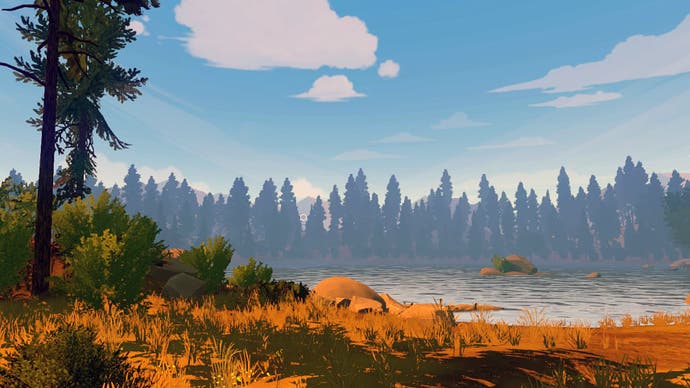
The summer forest fires are part and parcel of the landscape of Firewatch, actively contributing to the land's life cycle and often dictating interaction and use of the environment. It is most obvious at those particularly-scorched areas where the pine trees thin out, the ground is barren featuring bare rocks and hard, gravelly ground and only the most stubborn of plant species have returned. The fires of past summers seemingly shape the look, feel and content of the landscapes of future summers. A final nod back to the pleasant water features, while fire acts as the chaos and tensions and danger of the summer lands, the water acts as the diffuser, the calmer and the relaxing offset in the land - and to Henry.
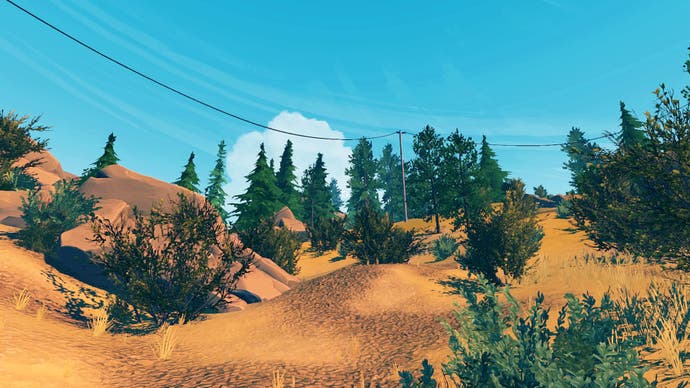
Firewatch's summer is simplified using stylised vegetation and trees, and broad-brush strokes of pastel colours minimises the landscape's complexity while maintaining a distinct atmosphere and sense of place. An indisputably bright and breezy summer landscape, Firewatch's use of the season is incredibly pleasant aesthetically yet also has the power to effectively act as a narrative and framing tool. This assists in exaggerating and enhancing a sense of escapism and peace but in a vivacious environment and allows for more attention to be given to the gripping narrative, and further immersion. The game feels a lot like getting lost in the woods, and there is a certain kind of trepidation to that. However, it's a pleasant 'lost', surrounded by plants and water, which makes it a successfully beautiful summer landscape that also enhances the games context, concepts and themes.

The distinctly Mediterranean summer environment of Karnaca in Dishonored 2 and Death of the Outsider directly, and powerfully, contrasts that of the grey and autumnal-feeling one of northern-European-style Dunwall. However, unsurprisingly, it has just a powerful sense of place, and the summer landscape and features play their part in contributing toward that. It utilises summer to portray a land at home under the constant pressure of the sunshine, but one that flourishes in it, too.
This is clear all over Karnaca, and immediately in the streets and open spaces that greet Emily, Corvo and Billy when in the coastal city. Reminiscent of the Amalfi Coast, the sun beats down incessantly onto dry and dusty streets and squares, making for a sweltering atmosphere - it feels hot just navigating around there. However, the architecture, design and aesthetic are made for it and work with, or at least to mitigate, the sun and heat: the buildings are light in colour to reflect the sun and heat; windows and alleys often point towards the coast to capture cooling breezes; the settlement grows outward from the coast - the main hub of the city - and up the hillsides; and although not always regular or particularly patterned, trees and climbers appear, up walls and rock faces softening hard edges and materials.
The use of such design and plants extends throughout the public spaces of Karnaca and is accurately apparent from streetscapes and alleys to squares, all in a summer's context. The streets of the Jewel of the South are littered with seating areas, viewing points and nodal spaces. And these themselves have clearly been designed and finish with summer in mind. Plants such as broad-leaved deciduous specimens and climbers are never far away, providing ornament but also shade, and softening the hard geometry of the architecture. This could nod to the Mediterranean pace of life in Karnaca, it being a place to be enjoyed, perhaps at a stroll, by visitors and inhabitants. Enjoying views, taking drinks outdoors and sitting among plants are all staples of the idea of outdoor spaces' use and function in summer and Mediterranean design.


Where streets converge and where there are larger, more open spaces, such as squares, station frontages and stream-side areas, this 'design for summer' approach is even clearer. The public square outside the Red Camellia Parlour and the not-totally-public frontage to Karnaca bank's are fine examples of this. Both are sheltered somewhat by nearby tall buildings, whose shadows cast areas of respite from the sun; in the case of the Bank's square the buildings also provide covered walkways - like a Roman peristyle garden - to avoid the sun's gaze - in the absence of any trees, which would block the intimidating view of the bank's frontage. Both are designed around a central focal point and near-symmetrical axis, and include steps down toward a central water feature - filled with lilies that provide bangs of colour - with seating pointing toward it at the Red Camellia, but away from it, curiously, at the bank - which is a pleasant design technique and, despite the statues' dominance, the sound of water and reflective quality of it, make for cooling atmospheres at both locations. Add in some plants - a mix of flowering ornamentals, the water lilies in the pond, clipped specimens for a bit of order and some climbers (on the bank's square's deep steps), all arranged fairly neatly - and a summer's open square design is complete.


Beyond the plants sun-baked spaces among and in Karnaca's streets, there are gardens clearly designed for summer use and summer enjoyment that demonstrate Dishonored 2's deployment of a summer landscape. The Duke's Palace is a magnificent example of this and the first glimpses of it make this obvious. The massive statues aside, the front garden's Mediterranean design and features speak volumes about how summer should be welcomed into the garden and sets up the intrinsic connection between the two. The large reflective pond, dotted with lilies, and with giant stepping stones flanked by an elaborate water fountain immediately provides the sounds and cooling nature a summer's garden would need. Reflecting the sun up and away from the garden with white reflective materials, mean the harder elements do a similar job. From here, there are magnificent views back across the bay, emphasising the Duke's control and extent of his power, allowing for enjoyable vistas in the face of a sea breeze, encouraging the coastal landscape to be soaked up. This is continued into the grounds elsewhere, with multiple viewing spaces designed from which a summer's view can be enjoyed. At some points these views are reinforced with areas of other function such as dining, games or painting often under the dappled cover of enormous pergolas.

White render walls are prevalent throughout to reflect heat and create raised planters or ponds for an array of species, all looking their best in the summer. Bromeliad-looking plants, ferns and brad-leaved hosta-like species appear throughout here but it is the olive-esque trees which are the stand out species again. Gnarled and characterful, the Duke's garden has many of them and has ordered them neatly and arranged them to his will. It is this particular species, combined with the others, the pergolas, the viewing points and the glorious water feature that combine to encapsulate the summer landscape design.

The gardens and spaces of Karnaca go some way to mitigating the unrelenting sun, dryness and dust of the city, but the role of summer and the sun is ever present. Perhaps the unrelenting heat and sun is reflective of the magnification Corvo or Emily are under - it seems to effectively mirror the pressure they are under. It also provides a natural inhibitor and something else that will take a toll during such a hard-fought journey. Nonetheless, it is the same summer that allows for Karnaca to have spaces governed by, and specifically designed for summer.
The polar opposite of winter and a lush development on spring, summer covers landscapes in life, revealing the true role of plants, vegetation, designed spaces, and the vibrancy on offer in game environments. While at first glance summer lands can be seen as indistinguishable from spring ones, the light, plants and sheer abundance of foliage and takeover of life in the landscape sets it apart from its brother season.
In its plant life and aesthetic design there are great opportunities, made the most of by these games, to demonstrate landscape fidelity and authenticity, while neatly cutting this with place-making, meaning and narrative-affecting or mirroring qualities. The designed spaces in games truly come to life, both literally and figuratively, in summer and their arrangement and composition come under scrutiny because the season makes their purpose clear and complete - putting meat on the bones winter showed, and spring sprouted from. The summer landscapes games provide make incredibly pleasant and joyful ones, providing lush virtual summer destinations and intensifying our enjoyment of the season, particularly on the real world's season's inevitably rainy days.
